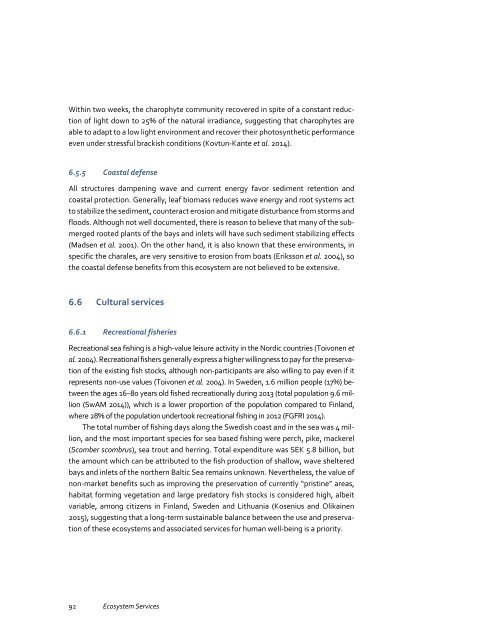Ecosystem Services
FULLTEXT01
FULLTEXT01
You also want an ePaper? Increase the reach of your titles
YUMPU automatically turns print PDFs into web optimized ePapers that Google loves.
Within two weeks, the charophyte community recovered in spite of a constant reduction<br />
of light down to 25% of the natural irradiance, suggesting that charophytes are<br />
able to adapt to a low light environment and recover their photosynthetic performance<br />
even under stressful brackish conditions (Kovtun-Kante et al. 2014).<br />
6.5.5 Coastal defense<br />
All structures dampening wave and current energy favor sediment retention and<br />
coastal protection. Generally, leaf biomass reduces wave energy and root systems act<br />
to stabilize the sediment, counteract erosion and mitigate disturbance from storms and<br />
floods. Although not well documented, there is reason to believe that many of the submerged<br />
rooted plants of the bays and inlets will have such sediment stabilizing effects<br />
(Madsen et al. 2001). On the other hand, it is also known that these environments, in<br />
specific the charales, are very sensitive to erosion from boats (Eriksson et al. 2004), so<br />
the coastal defense benefits from this ecosystem are not believed to be extensive.<br />
6.6 Cultural services<br />
6.6.1 Recreational fisheries<br />
Recreational sea fishing is a high-value leisure activity in the Nordic countries (Toivonen et<br />
al. 2004). Recreational fishers generally express a higher willingness to pay for the preservation<br />
of the existing fish stocks, although non-participants are also willing to pay even if it<br />
represents non-use values (Toivonen et al. 2004). In Sweden, 1.6 million people (17%) between<br />
the ages 16–80 years old fished recreationally during 2013 (total population 9.6 million<br />
(SwAM 2014)), which is a lower proportion of the population compared to Finland,<br />
where 28% of the population undertook recreational fishing in 2012 (FGFRI 2014).<br />
The total number of fishing days along the Swedish coast and in the sea was 4 million,<br />
and the most important species for sea based fishing were perch, pike, mackerel<br />
(Scomber scombrus), sea trout and herring. Total expenditure was SEK 5.8 billion, but<br />
the amount which can be attributed to the fish production of shallow, wave sheltered<br />
bays and inlets of the northern Baltic Sea remains unknown. Nevertheless, the value of<br />
non-market benefits such as improving the preservation of currently “pristine” areas,<br />
habitat forming vegetation and large predatory fish stocks is considered high, albeit<br />
variable, among citizens in Finland, Sweden and Lithuania (Kosenius and Olikainen<br />
2015), suggesting that a long-term sustainable balance between the use and preservation<br />
of these ecosystems and associated services for human well-being is a priority.<br />
92 <strong>Ecosystem</strong> <strong>Services</strong>


